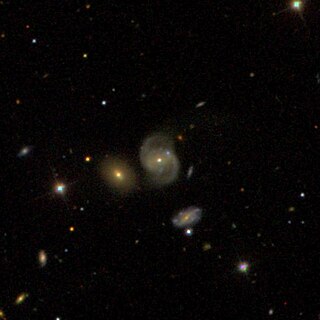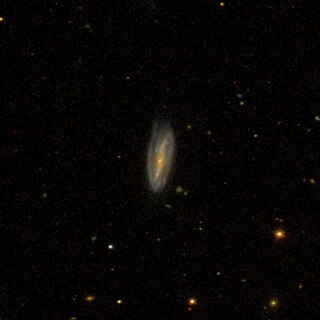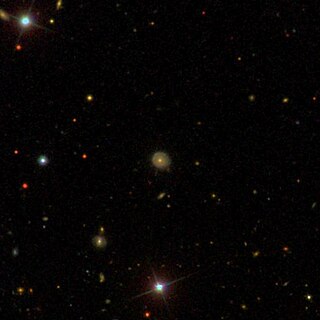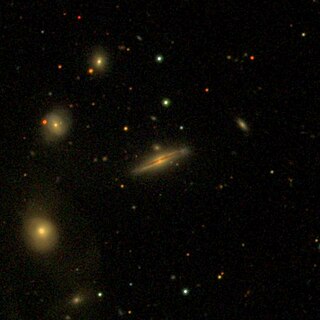
IC 4461 is a spiral galaxy located in the Boötes constellation, located at distance of 417 million light-years from both the Milky Way and Andromeda Galaxy.

IC 3505 is a barred spiral galaxy located 640 million light-years away from the Solar System in the Coma Berenices constellation. With an apparent size of 0.95 by 0.35 arcmin, IC 3505 has an estimated diameter of 170,000 light-years, making it slightly larger compared to the Milky Way. It is categorized as a LINER galaxy with an active galactic nucleus emitting weak emission-lines.

IC 3246 known as PGC 40202, is a barred spiral galaxy with a ring located in the Virgo constellation. It is situated 1.13 billion light-years away from the Solar System and was discovered by Friedrich Karl Arnold Schwassmann on September 14, 1900. IC 3246 has a surface brightness of 23.6 magnitude/arc seconds and located at right ascension and declination respectively.

IC 3482 is a type Sb spiral galaxy in the Coma Berenices constellation. It is located 850 million light-years away from the Solar System. IC 3482 has an apparent size of 0.4 x 0.15 arcmin, meaning it has estimated diameter of 140,000 light-years. IC 3482 was discovered on March 23, 1903, by German astronomer pioneer, Max Wolf. It is located at right ascension of (12:33:01.00) and declination of (27:49:49:10), and has a surface brightness of magnitude 23.

IC 4000 known as PGC 2152407, is a type Sbc spiral galaxy with a ring in the constellation of Canes Venatici. It is located 1.5 billion light-years away from the solar system and has an estimated diameter of 100,000 light-years which is the same length as the Milky Way. IC 4000 was discovered by Max Wolf on March 21, 1903. It has a surface brightness of 23.3 magnitude/arc seconds and located right ascension (12:59:36.62) and declination (39:35:15:90).

IC 1192 is an edge-on barred spiral galaxy located in Hercules. It is located 543 million light-years from the Solar System and has a diameter of approximately 90,000 light-years. IC 1192 was discovered by Stephane Javelle on August 13, 1892. It is a member of the Hercules Cluster.

IC 2498 known as PGC 27668, is a type Sb barred spiral galaxy located in constellation Leo. It is located 469 million light-years away from the Solar System and was discovered by Stephane Javelle on April 30, 1896.

IC 2816 known as PGC 3472124, is a type Sbc spiral galaxy with a ring structure located in the Leo constellation. It is located 878 million light-years from the Solar System and has apparent dimensions of 0.59 x 0.22 arcmin, meaning its diameter is 160,000 light-years across.

IC 3622 also known as PGC 3793395, is a large barred spiral galaxy located in constellation Coma Berenices. It is located 980 million light-years from the Solar System and has a diameter of 175,000 light-years. IC 3622 was discovered by Royal Harwood Frost on May 7, 1904.

IC 3222 known as PGC 40065 and UGC 7437, is a barred spiral galaxy with a ring structure located in the constellation of Coma Berenices. It is located 869 million light-years from the Solar System and has dimensions of 0.90 x 0.6 arcmin, meaning IC 3222 is 235,000 light-years across in diameter. This makes it a large galaxy. IC 3222 was discovered by Max Wolf on March 23, 1903.

IC 3683 known as PGC 1637726, is a barred spiral galaxy with a ring structure located in Coma Berenices. It is located 853 million light-years from the Solar System and has an apparent dimension of 0.30 x 0.2 arcmin. IC 3683 was discovered by Max Wolf on January 27, 1904.

IC 838 known as NGC 4849A,PGC 44444 and other names, is a type Sbc barred spiral galaxy located in Coma Berenices. Its redshift is 0.069181, meaning the galaxy is located 954 million light-years from Earth. IC 838 was discovered by Rudolf Spitaler on February 24, 1892 and has an apparent dimension of 0.50 x 0.5 arcmin, meaning it is about 140,000 light-years across. IC 838 forms an optical pair with the lenticular galaxy NGC 4849, located south, which together makes up HOLM 495.

IC 848 is a type Sbc barred spiral galaxy located in Coma Berenices. Its redshift is 0.053077 which corresponds the galaxy to be located 727 million light-years away from Earth. IC 848 has an apparent dimension of 0.80 x 0.6 arcmin, meaning it is about 170,000 light-years across. It was discovered by Stephane Javelle on July 22, 1892, which was described per Dreyer as "extremely faint, very small and difficult".

IC 3278 known as PGC 40345, is a large type SBbc spiral galaxy located in Coma Berenices. Its redshift is 0.093851, meaning IC 3278 is 1.29 billion light-years away from Earth, which given its apparent dimensions of 0.80 x 0.6 arcmin, means IC 3278 is 301,000 light-years across. The galaxy was discovered on March 23, 1903, by Max Wolf. Together with two lenticular galaxies, IC 3278 NED01 and IC 3278 NED02, they form a galaxy triplet bearing its same name. According to a study which was conducted by Takase and Miyauchi-Isobe, IC 3278 can be considered an ultraviolet-excess galaxy as it is detected on multi-color plates which was taken via a Kiso Schmidt telescope for 10 survey fields.

IC 4539 is a type SABb intermediate spiral galaxy located in Corona Borealis. Its redshift is 0.061307, which corresponds IC 4539 to be 845 million light-years from Earth. It has an apparent dimension of 0.40 x 0.4 arcmin, meaning the galaxy is about 95,000 light-years across. IC 4539 was discovered by Stephane Javelle on June 23, 1903, who found it "as faint, small, round with a very brighter middle."

IC 4160, also known as PGC 1677859, is a spiral galaxy located in Coma Berenices. Its redshift is 0.061443, which corresponds IC 4160 to be 846 million light-years from Earth. It has an apparent dimension of 0.40 x 0.2 arcmin, meaning the galaxy is 99,000 light-years across. IC 4160 was discovered by Max Wolf on January 27, 1904.

IC 2754 is a type Sc spiral galaxy located in the constellation Leo. Its redshift is 0.070479, which corresponds to IC 2754 being 970 million light-years from Earth. It has an apparent dimension of 0.50 x 0.2 arcmin, which means IC 2754 is 141,000 light-years across. IC 2754 was discovered on March 27, 1906, by Max Wolf.

IC 2839, known as PGC 3472295, is a spiral galaxy located in the constellation Leo. Its redshift is 0.065734, which corresponds to the galaxy being located 906 million light-years from Earth. IC 2839 has an apparent dimension of 0.30 x 0.1 arcmin, meaning it spans 79,000 light-years across. The galaxy was discovered on March 27, 1906, by Max Wolf.

IC 4481 is a type SBbc barred spiral galaxy located in Boötes. Its redshift is 0.110727, meaning IC 4481 is located 1.49 billion light-years away from Earth. It is one of the furthest objects in the Index Catalogue and has an apparent dimension of 0.30 x 0.2 [[Minute and second of arc|arcmin]. IC 4481 was discovered on May 10, 1904, by Royal Harwood Frost, who found it "faint, very small, round and diffuse".

IC 3447 is a type Sc barred spiral galaxy located in the constellation Virgo. It has a redshift of 0.092479, which means IC 3447 is 1.27 billion light-years from Earth, making it one of the furthest objects in the Index Catalogue. The galaxy has apparent dimensions of 0.30 x 0.3 arcmin, which means IC 3447 is 111,000 light-years across. It was discovered by Royal Harwood Frost on May 10, 1904.




















